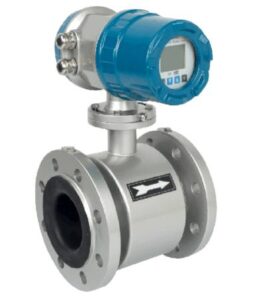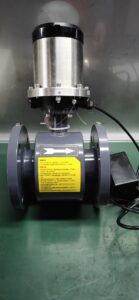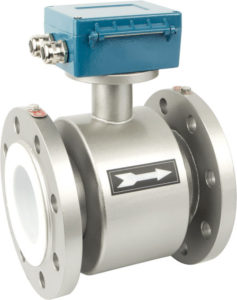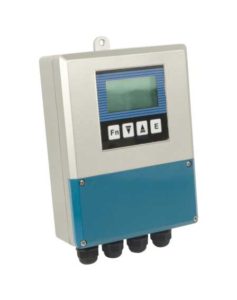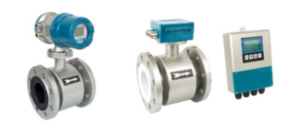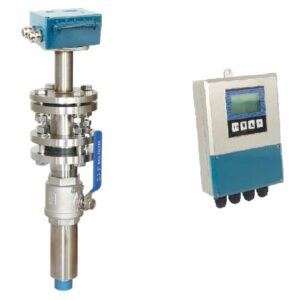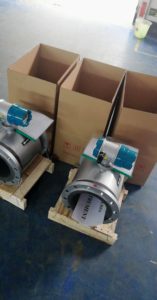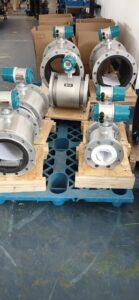1. Strong magnetic field
Since it is generally noted to be far away from the strong magnetic field during installation, there are not many cases where the strong magnetic field affects the practice.
2. Strong electromagnetic wave
The electromagnetic flowmeter should meet the requirements of electromagnetic compatibility, work normally under the specified radiated electromagnetic field environment, and will not cause the instrument performance to decline or work abnormally in this environment.
Case study: A water plant installed multiple electromagnetic flowmeters, and the output of one of them fluctuates greatly. On-site check that the installation of the instrument meets the requirements, the flow sensor, and the converter are 50m apart and are connected with a shielded cable placed in the iron conduit.
The instrument itself is also normal. But the measured common mode interference signal is as high as 1.7V. First, take measures to electrically insulate the flow sensor. The common-mode signal is reduced by 0.6V, but the output fluctuation is not significantly improved.
Analyze the on-site environmental conditions with the user again, and learned that there is a strong radio transmitting station very close to the flowmeter. In order to verify whether the cause of the fault came from the interference source, the converter was temporarily moved to a place where the flow sensor was 3m away, and the common-mode interference signal was retested to be less than 0.1mV. Although it still felt too large, the operation of the instrument tended to be normal. The cause of the failure is that even if the signal line is shielded by multiple layers, electromagnetic waves are still drawn to the instrument.
This example reveals that when the separate electromagnetic flowmeter has large common-mode interference on site, the possibility of strong radio waves becoming the source of interference should be considered when analyzing the cause of the failure. This example is a rare failure during the debugging period.
3. Stray current in pipeline
After the electromagnetic flowmeter is properly grounded, the influence of most of the stray current in the pipeline can be avoided. Sometimes a thick wire is used to bridge the flow sensor and perfect grounding according to regulations, but it is still affected by stray current, and other measures need to be taken.
Case study: An aluminum smelter uses DN to detect 80mm electromagnetic flow to detect lye pulp. The flow sensor is equipped with grounding rings at both ends and is connected with a wire and is properly grounded. However, the meter still does not work until it is moved 2m outwards and then two grounding points are installed. , Isolate the influence of stray current.
After the instrument is put into normal operation for a period of time, the output signal shakes again.
Excluding the possibility of flow fluctuations, the meter itself is intact, and it is preliminarily judged that the meter is operating abnormally. Observed for several days, it was found that the noon lunch break and the evening shift were operating normally, while the output of the day shift was shaking. Based on this clue, the source of the fault was traced and the source of the fault was found to be caused by electric welding on the same pipe system far away from the electromagnetic flow sensor.
Case study:
The electromagnetic flow sensor is insulated from the connecting pipeline, which can eliminate the influence of large stray currents.
A water company installed two DN900 electromagnetic flowmeters, one of which is operating normally, and the other is fluctuating up to 50% FS within a period of 1-2h. The user believes that the operating conditions of the two instruments are similar, and the fault is caused by the instrument.
In the surrounding environment of the survey site, upstream and downstream of the flow sensor are two sections of 0.5m long unlined short steel pipes with good grounding, and then connected to the cement-lined steel pipes. Electrical connections such as grounding are in compliance with the requirements, and at the same time, the possibility of arterial movement of the steel mesh is eliminated.
The distance between the converter and the sensor is about 10m. A three-phase transformer with hundreds of kilovolt-amperes is installed nearby, about 2m and 8m away from the converter and the sensor, respectively.
There are two possibilities for analyzing the cause of the fault:
(1) Magnetic field interference generated by high-power transformers;
(2) Stray current interference on the pipeline. It is necessary to prove whether it is the influence of the magnetic field interference of the transformer and because the transformer has to be shut down, it is arranged as the second step of inspection. First, check whether it is the interference of pipeline stray current.
Use an oscilloscope to measure the potential between the two poles without excitation current, and its value should be zero. However, the actual measured peak value Vpp is as high as 1V and the waveform distorted AC potential. It is preliminarily determined that even if the grounding is good, the instrument will be affected by the interference of pipeline stray current.
The electromagnetic flow sensor and two short steel pipes are electrically insulated from the pipe network so that the flow sensor and the liquid have the same potential. When the meter is put into operation, the output display is stable and normal, and the influence of the magnetic field interference of the power transformer on the flow measurement is also eliminated.
At the same time, the measured interference current is 60mA AC. The direction of the current comes from the upstream of the flow sensor. This measure is also applicable to pipelines with cathodic protection currents, as a way to try to eliminate the influence of pipeline current interference.
4. Ground potential change
The ground potential change will affect the flow measurement. For example, the voltage drop on the ground wire of other equipment can change the ground potential of the electromagnetic flowmeter. If a large common-mode interference is formed, it will affect the measurement.
5. Moisture immersion
Electromagnetic flowmeters used in water supply and drainage industries often install flow sensors in meter wells below the horizon, so they are often immersed in rainwater that has not been discharged in time or even immersed in water for a long time.
Even if the enclosure protection level is IP67 (dust-tight and short-time immersion level) or IP68 (dust-tight and continuous water immersion level), the sealing gasket of the terminal box cover or the cable introduction sealing ring will not be compressed and sealed, and the ring will be omitted. Or the ferrule does not match the outer diameter of the cable, and such accidents often occur.
If the sealing gaskets such as the cover of the flow sensor on the ground are not sealed well, the moisture will be inhaled by the respiration of the temperature change, and it will condense into water.
The terminal box cable guide device is missing a sealing ring or is not tightly sealed, and the condensed water on the surface of the cable is also very easy to enter the terminal box. Such cases are not uncommon. In the process of construction, the cable was cut off intentionally or unintentionally, and then reconnected, and sealed with tape.
This hidden danger will not cause a malfunction in the early stage of operation, but the encapsulation will age over time, the connection will absorb moisture, and the cable insulation will be reduced.
Water and moisture invade the terminal box, reducing the insulation strength and insulation resistance. In severe cases, the flow signal circuit will have no flow signal output, and the excitation coil circuit will form a zero offset or instability. If necessary, water-sealing measures such as silica gel can be taken at the sealed connection.
The non-air-tight structure of the excitation coil protects the shell, which inhales moisture due to breathing. If the liquid temperature is lower than room temperature, it is easy to condense on the outer wall of the measuring tube.
Case study: A water plant uses a DN1200 electromagnetic flowmeter to measure water from the Yellow River, another DN900 meter measures groundwater into the plant, and two DN100 meters measure the product water in parallel. Two years after the system was put into normal operation, it was found that the factory water was 10%-15% more than the incoming water. Observe the operation of the instrument without abnormal performance.
A comparative test was performed on 4 electromagnetic flowmeters with external clamp transducer (probe) portable ultrasonic flowmeters, which proved that the output signals of the two factory electromagnetic flowmeters were relatively high. Turn off the stop flow and check the zero points respectively, and found that the zero points of the two factory water measuring instruments have greatly shifted. Judging from experience, it may be caused by the water in the terminal box or the dampness of the excitation coil, and the decrease in insulation.
When the dew is wiped off, use a hairdryer to dry the terminal block of the junction box. The resistance of the excitation terminal to the ground is restored from 5-6 megohms to tens of megohms.
The reason is that the insulation of the excitation coil circuit to the ground is reduced so that a larger insulation resistance and the signal internal resistance to the excitation voltage are added to the electrode to form a larger common-mode interference signal, and the converter preamplifier The ability of the mode rejection ratio is limited so that the converter has an output at the zero point

